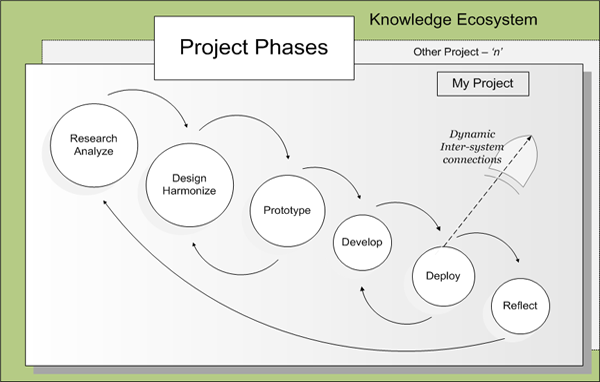Process
Architects are an integral part of project planning. In the built environment, the primary effort of an architect is to design a building. Information architects are part of the
initial creative energy needed to design a new interaction. Or, entire systems of interaction within the life cycle of a major product.

Every information technology organization has a methodology similar to the image above. The goal of such a process is to avoid the twin extremes of project planning: hasty execution, or delays caused by "analysis paralysis."
That is, planning should occur before implementation (yes, sometimes people do code before the specifications have reached a tolerable level of flux). And, development should begin before every detail has been specified.
The illustration above is merely a visual of the six phases described below. It is meant to convey a simple abstraction of the project process. Indeed, a simple definition is most sensible. The reality of each design effort is unique and will dictate a distinctive approach for every project plan.
Agile development
The current paradigm
The diagram above is relatively simple - and, consequently, does not capture several ideas.
One important concept is that overlap exists across phases. That is, some design work can proceed before all research is complete. User definitions (and, re-definitions) are often a constant thread throughout the life of a project.
And, these phases, often seen as discrete, have components within them that are iterative. They reoccur in light of knowledge that is revealed in subsequent phases.
The sub-pages within this section are suggestions about the types of activities that may occur and documents that may be produced in each phase of a specific project. But, again, each project is unique.
Specific phases
The æolian view
A Summary:
- Research & Analyze
Initial phase within the context of an entire ecosystem.
This is the phase in which Information Architecture begins. - Design & Harmonize
Develop functional requirements in the context of user needs and wants. - Prototype
Develop a preliminary model to be tested by users. - Develop
implementation in robust production environment. - Deploy & Refine
Installation of Release 1.0 – preparations for Release 2.0. - Reflect
Unforeseen opportunities and connections - a moment for learning and recording new insights.

